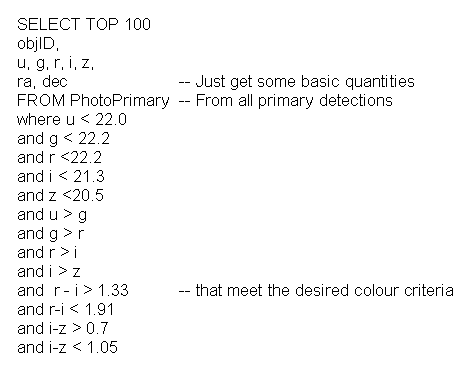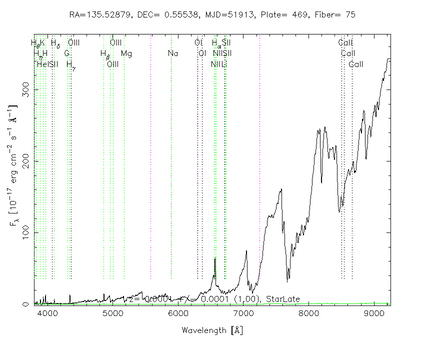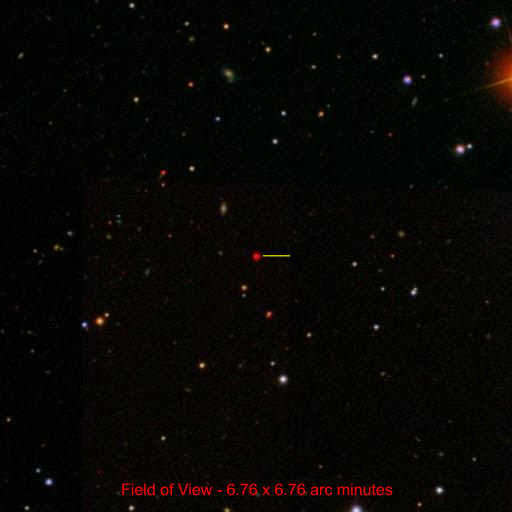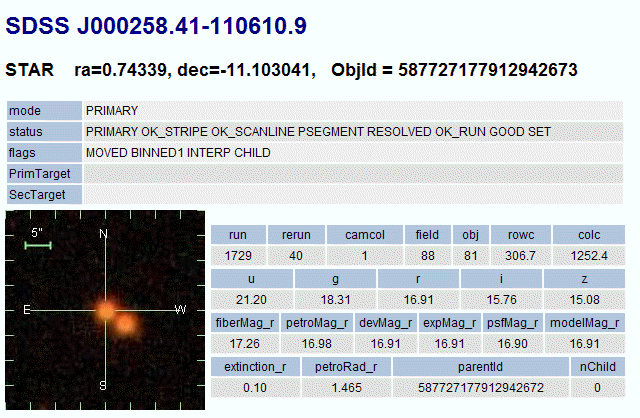

Return to the front page of Martin Nicholson's Double Star Projects
| Correcting WDS | Data Mining for doubles | Designed to fail? | Stellar Twins | Red Dwarf Binary Pairs |
Red dwarfs are by far the most common but also the most inconspicuous type of star. They are cool, small (7% to 60% of solar mass), main sequence stars found towards the lower right hand corner of the Hertzsprung-Russell diagram.
Some red dwarfs are flare stars with frequent eruptions that greatly increase their brightness for a short time. These flares only take a few minutes to reach maximum brightness and flare stars erupt at irregular intervals with flares spaced anything between an hour and a few days apart.
Techniques have been developed to identify red dwarf in the Sloan Digital Sky Survey (SDSS)- Data Release 5. The table below is extracted from the article "Updated colors for cool stars in the SDSS".

The CasJobs facility can be used to search for specific classes of astronomical objects within the SDSS database. The script shown below demonstrates how this can be done. The key features of the script are as follows:-

In this example I required all five bands of magnitude data for 100 stars with three distinct sets of constraints applied to the star chosen. The first constraint excluded very faint stars, the second excluded stars that previous trials had shown to have photometric errors and the third made use of the published chart, as shown above, to select a sub-type of red dwarf centered around spectral type M4. The script can, of course, be modified to suit what the user requires but I find it convenient to limit the output to 65,000 stars so that subsequent data manipulation using the spreadsheet Excel is simplified.
An alternative approach is to input any constraints into the Spectroscopic Query Form. This has the advantage that it will only yield results for candidates with an available spectra but searching is much slower and of course many stars matching the constraints don't have a spectra recorded.
 |
 |
| M1 star (Late-type star, M or later) | M3 star (Late-type star, M or later) |
 |
 |
| M5 star (Late-type star, M or later) | M8 star (Late-type star, M or later) |
Target #1 - 09 02 06.91 +00 33 19.4 in Hydra


This looks like an M8 star and this is encouraging as this is the type of star that we are targetting. When we put the results into Vizier, what do we find?
| The SDSS Photometric Catalog, Release 5 (Adelman-McCarthy + 2007) | 09 02 06.91 +00 33 19.4 |
| LSPM-North proper-motion catalog nearby stars (Lepine+, 2005) | Name LHS 5142 pmRA = -0.463 pmDE = -0.108 Distance 26.2pc |
We have found a nearby star with a high proper motion. Again what we would expect since red dwarfs of this type are so faint that they can only be detected when close by. The Catalogue of Stellar Spectral Classifications (Skiff, 2007) does not report on LHS 5142 so the spectral classification of M8 is a new discovery.
It is possible to use the published data on SDSS red dwarfs to determine many of the key characteristics of the individual stars. This was well explained in an article by Edgardo Rubén Masa Martín published in the Journal of Double Star Observations. I recently, June 2007, extracted the details of 984,000 red dwarfs to form the basis for potential project work.
The method used to convert astrometric data to a list of candidate binary stars of any chosen angular separation is described in detail in my article in the Journal of Double Star Observations entitled "Unreported High Proper Motion Northern Double Stars in the LSPM Catalog". Each candidate pair is then examined to see if the two stars are at very similar distances based on the results from project 2.
Example Pair #1 - in Cetus, analysis by Martin Nicholson and Hannah Varley. For details of methodology used see http://www.jdso.org/Winter2007/Masa.pdf
| u mag | g mag | r mag | i mag | z mag | RA | DEC | |
| Primary | 21.20 | 18.31 | 16.91 | 15.76 | 15.08 | 0.74339 | -11.10304 |
| Secondary | 21.20 | 18.42 | 17.01 | 15.81 | 15.17 | 0.74238 | -11.10370 |
| V band | Distance | % difference | Spectrum | Absolute | Separation at | ||||
| mag | SEP | PA | Parsec | in distance | M class | Magnitude (Mv) | Solar mass | mean distance (AU) | |
| Primary | 17.53 | 4.52 | 235.7 | 214.6 | 0.2 | 2 | 10.9 | 0.39 | 971 |
| Secondary | 17.65 | 214.9 | 2 | 11.0 | 0.38 |

Digitized Sky Survey Image
All 594 red dwarf binary candidates
In collaboration with the Remote Astronomical Society Observatory
Martin Nicholson - Daventry, United Kingdom.
This page was last updated on February 23rd 2008.